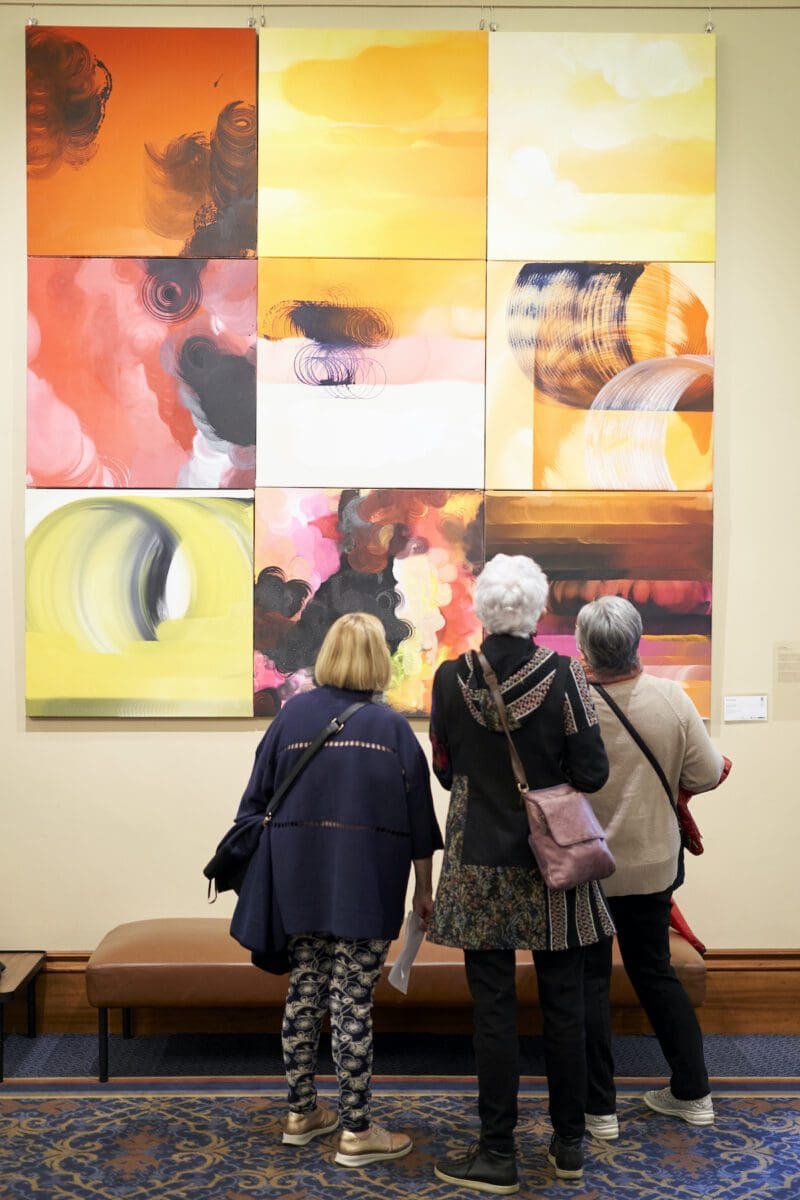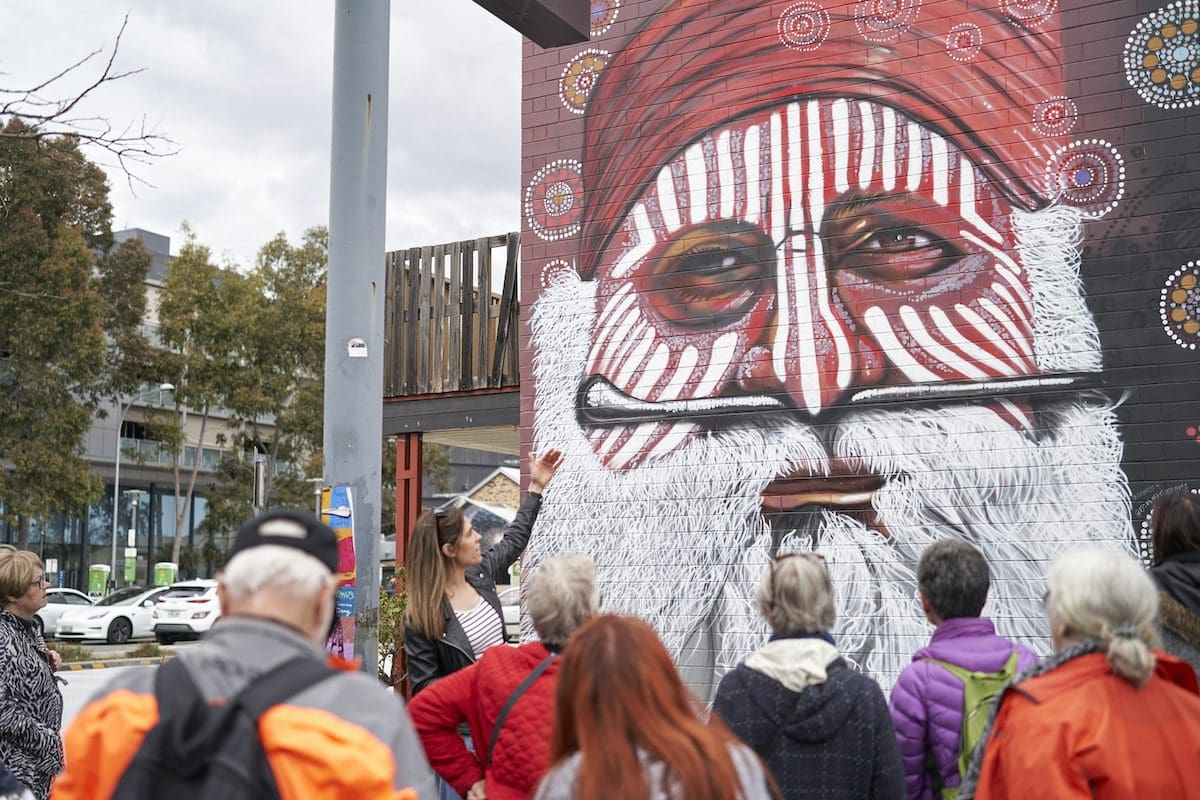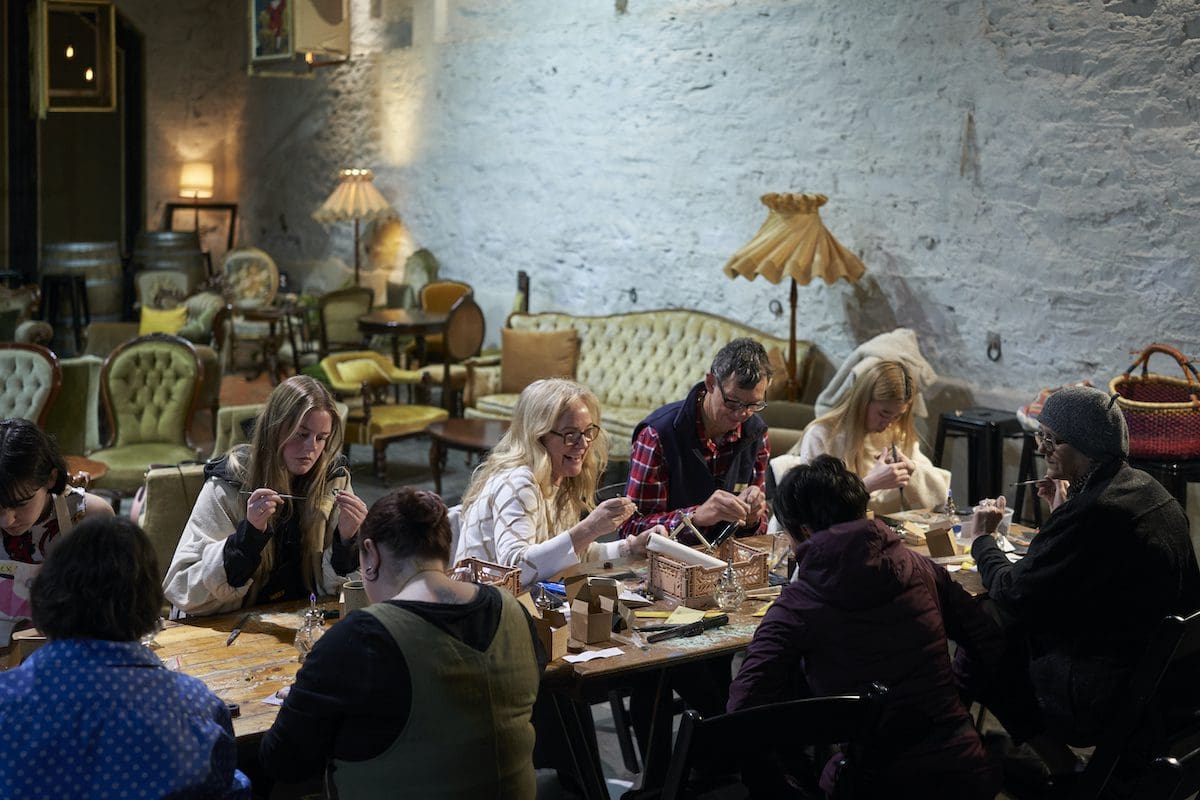
Making Space at the Table
NAP Contemporary’s group show, The Elephant Table, platforms six artists and voices—creating chaos, connection and conversation.






In a curtain-partitioned cavern in the oldest intact theatre in mainland Australia upon ancient Kaurna land, Adelaide’s contemporary visual artists have come to spruik and carouse.
“Close your eyes to feel where you are,” says artist Gail Hocking on a stage beneath rows of fairy lights strung under the vaulted tin ceiling, relaying her father’s advice on how to survive by using all senses.
Born and raised in Aotearoa New Zealand, Hocking’s ceramics, installations, and sculptures draw parallels between human and ecological frailty. She creates shapes to hold memory, her art guided by a principle straight from a Maori proverb—I am the river, the river is me.
The artists gathering this evening at the Queen’s Theatre for Slide Night are each given five minutes to summarise what they do. This venue in Tarndanya/Adelaide is just one of over 600 opening its doors for the South Australian Living Artists Festival, involving over 9,000 of the state’s artists throughout August.
In their practice, many of the local artists tread lightly yet roam widely for inspiration. A significant number continue to develop their talents in collegial artist collectives and shared spaces, even as 50 of the state’s arts luminaries last week decried the “dire state of the arts” in a letter to the Premier, Peter Malinauskas.
Artist Sarah Neville is up next. As an artist and choreographer, she is used to moving in immersive digital spaces using virtual and augmented reality, but she is keen to break down contemporary dance jargon. Neville and collaborating artists have created Glasshouse at the futuristic museum MOD., inviting members of the public to come together in a biosphere as “agents of interaction”.
Participants don VR headsets and choose to be a plant keeper, an insect, or a plant. You “activate your own world”, explains Neville, while interacting within an ecology grown live by others in VR headsets around you.
Meanwhile, Paul Gazzola, the artistic director of Adelaide’s Open Space Contemporary Arts, tells the Slide Night crowd that as an artist who trained in carpentry and dance but didn’t go to art school, he too “understands the world as a hands-on thing”.
He likes to put his artworks in public spaces “where people can live and walk to”, not centralised in the city, and criticises as “reductive” the notion that artworks should not be touched.
Having documented explosion aesthetics as a metaphor for the “volatility of ideas”, Gazzola throws down a challenge: “What’s wrong with touching things anyway? Surely, they’re not going to blow up.”
Two days later, I board a bus tour of east-side Adelaide artist studios, hosted by affable artist Oakey, who came to Australia from Brighton in the UK 14 years ago.
“It’s fantastic here,” says the former professional cricket player and coach, now making artwork inspired by long trips to the Amazon rainforest. “There’s such a strong artist community in Adelaide, and there’s new studios popping up all over the place.”
At Central Studios in Kent Town, which bills itself as “the oldest continuously running studio collective in Australia”, there are 21 artists, including Oakey, who each have a lockable studio.
In studio number one, artist Dan Withey, who came to Adelaide from Birmingham in the UK as a teenager, says the city has a big arts scene. “Everybody knows everybody – it’s quite nice, as long as you’re not a dick, I suppose,” he laughs.
Withey’s paintings pop with colour, but then you begin to notice surveillant eyes across his canvases. “You’re always being observed by someone,” he says. “I think people are a lot like bees, we’re really attracted to colour.”
Meanwhile, in 2021, printmaker Nadia Caon became aware that a space behind a shopfront in St Peters, previously home to a long-standing woodcarving workshop, had become vacant. Caon and three fellow printmakers moved in and opened the Laneway Print Studio, using techniques of relief and intaglio printing, raising $5,000 to buy a second-hand machine from a printer on Kangaroo Island, and sharing equipment.
The studio today has 15 members, and now an additional nine artists have moved into the shops in front of the print studio, leading to three connected rooms collectively known now as Parallel Studios, which include The Pod Gallery exhibition space.
Caon and her fellow artists hold regular ‘crit’ sessions of one another’s work. “It takes a bit of bravery,” she says. “But because we’re very familiar with each other, we’re quite honest with each other.”
The next stop on the tour is Mezzanine 55, a collection of artist studios in Rundle Street, where figurative sculptor Georgina Mills talks about her work in clay and her years of studying at the Florence Academy of Art in Italy.
Mills is surrounded by sculpted faces, death masks and a replica skeleton, and can pull a curtain across for privacy to work. “It’s supportive here,” she says. “Sometimes we don’t talk; it’s nice to share ideas and have a coffee, but most of us are busy balancing working jobs with our art practice.”
In the eclectic rabbit warren of Collective Haunt’s artist studios above shops, one suburb over in Norwood, the spaces are smaller, yet the atmosphere is lively.
In a rented exhibition space in the entrance foyer, I fall for a 28 x 36-centimetre oil work by artist Max Ballard, which depicts a pile of unread paperbacks on a bedside table, titled I’ll Get Round to It. I buy the painting directly from the artist on the spot, and a red sticker dot seals the sale.
South Australian Living Artists Festival
Adelaide and regional areas
On now—31 August